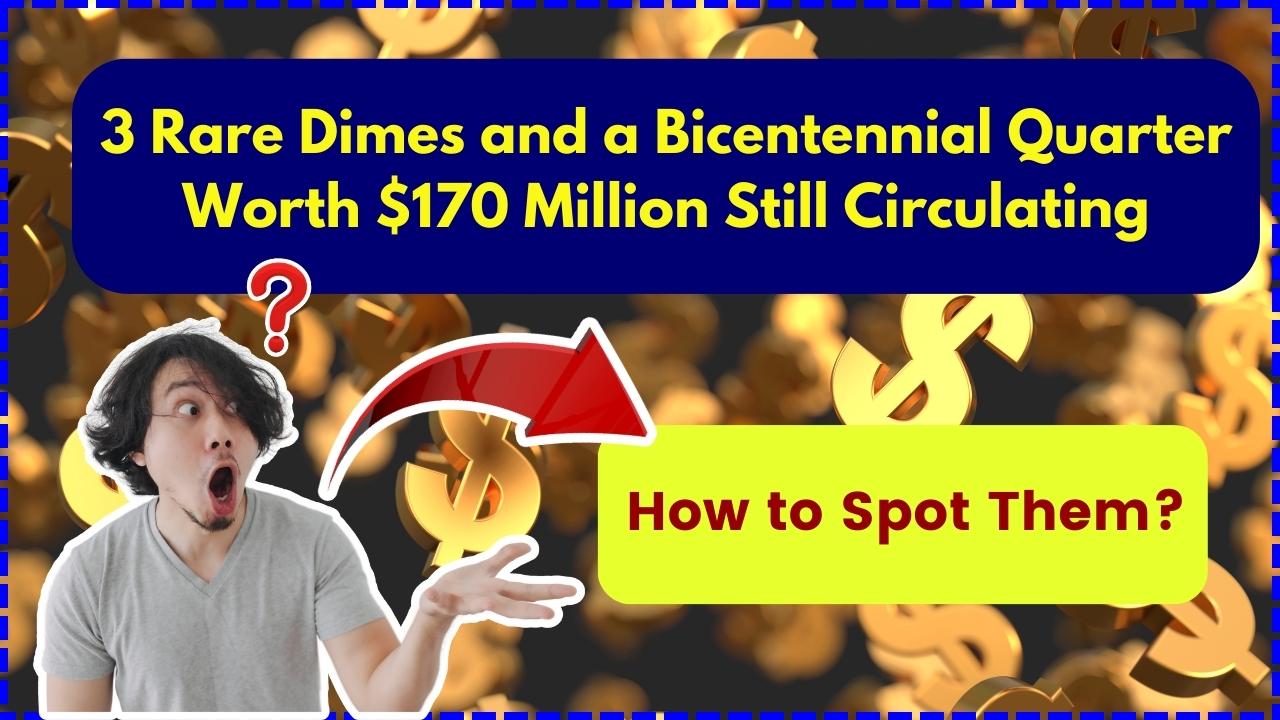Rare Dimes and a Bicentennial Quarter Worth $170 Million Still Circulating: Rare coins can be hidden treasures, sometimes worth millions. Among the most valuable coins still potentially in circulation are three rare dimes and a Bicentennial Quarter—together valued at a staggering $170 million. This article provides a detailed guide on how to identify these valuable coins, their historical significance, and tips to ensure you don’t miss out on a fortune hiding in your pocket change.
Rare Dimes and a Bicentennial Quarter Worth $170 Million Still Circulating
| Topic | Details |
|---|---|
| Rare Coins | 3 dimes and 1 Bicentennial Quarter worth $170M |
| Most Valuable Coin | 1975 No-S Proof Dime (worth over $500,000) |
| Common Errors | Double dies, no mint marks, off-center strikes |
| Where to Check | Pocket change, old coin collections, estate sales |
| Official Resources | United States Mint |
The chances of finding a rare dime or Bicentennial Quarter in circulation are low, but they do exist. By learning how to identify key features like mint marks, errors, and silver composition, you could potentially discover a fortune in your spare change. If you think you’ve found one of these rare coins, get it authenticated and graded to determine its true value.
Why Are Some Coins Worth Millions?
Coin values are determined by rarity, condition, and demand. When a coin is minted in small quantities, has a unique error, or was historically significant, it can fetch enormous prices from collectors. Some of these coins were never meant to enter circulation but did so by accident, making them even more desirable.
Factors That Make a Coin Valuable
- Limited Mintage: The fewer coins minted, the rarer they are.
- Minting Errors: Coins with errors like missing mint marks, double dies, or misalignments can be worth significantly more.
- Metal Composition: Silver and gold coins hold higher value than standard copper-nickel coins.
- Historical Significance: Coins linked to important events or first-issue runs are highly prized by collectors.
- Condition (Grade): Coins in mint or near-mint condition (MS-65 or higher) fetch higher prices.
3 Rare Dimes You Should Look For
1. 1894-S Barber Dime
- Why it’s valuable: Only 24 were minted, with fewer than 10 known to exist today.
- How to identify it:
- Year: 1894
- Mint mark: “S” (San Francisco)
- Design: Features Lady Liberty with a laurel wreath on the obverse.
- Estimated value: Up to $2 million, depending on condition.
2. 1916-D Mercury Dime
- Why it’s valuable: First year of the Mercury Dime series, with only 264,000 minted in Denver.
- How to identify it:
- Year: 1916
- Mint mark: “D” (Denver, found on the reverse left side of the fasces).
- Design: Winged Liberty head on the obverse.
- Estimated value: Up to $300,000 in mint condition.
3. 1975 No-S Proof Roosevelt Dime
- Why it’s valuable: A rare minting error where the “S” mint mark was omitted from proof sets.
- How to identify it:
- Year: 1975
- No “S” mint mark below Roosevelt’s neck.
- Sold in special proof sets, but some accidentally entered circulation.
- Estimated value: Over $500,000, making it one of the most expensive dimes ever.
The Bicentennial Quarter Worth Millions
1976 Bicentennial Quarter (Silver Composition & Error Coins)
- Why it’s valuable: Certain Bicentennial Quarters, especially error coins and silver composition variants, are highly sought after.
- How to identify it:
- Year: 1776–1976 (dual date to commemorate the U.S. Bicentennial).
- Reverse design: A colonial drummer with a torch surrounded by 13 stars.
- Look for errors:
- Double die obverse/reverse (misaligned prints, especially on text and design).
- No mint mark errors (rare but valuable).
- 40% silver versions (have a different metallic ring when dropped).
- Estimated value: Some rare error versions have sold for over $50 million.
How to Check If You Own One of These Rare Coins
Step 1: Inspect Your Coins Carefully
- Use a magnifying glass or coin microscope to check for errors.
- Look for missing mint marks, double dies, or other anomalies.
Step 2: Compare With Online Resources
- Visit PCGS or NGC to verify authenticity.
Step 3: Get a Professional Appraisal
- If you suspect you have a rare coin, consult a professional numismatist or coin grading service.
- Use services like PCGS, NGC, or ANACS to get an official certification.
Step 4: Proper Storage
- Store rare coins in airtight holders or slabs to prevent damage.
- Avoid handling with bare hands to maintain condition.
Rare 1970-D Kennedy Half Dollar Error Coin Valued at $350,000 – Do You Have It?
$150,000 for an 1829 Capped Bust Dime? Discover 5 Other Rare and Iconic Coins!
Lincoln Wheat Penny Worth $25 Million? Here’s How to Spot This Rare Coin!
FAQs About Rare Dimes and a Bicentennial Quarter Worth $170 Million Still Circulating
1. Are these coins still in circulation?
Yes, although extremely rare, some of these valuable coins could still be found in circulation, especially the 1976 Bicentennial Quarter.
2. How can I tell if my coin is silver?
Check the coin’s edge:
- A solid silver edge indicates a silver coin.
- If there is a copper stripe, it’s not silver.
3. Where should I sell my rare coin?
Sell rare coins through reputable sources like Heritage Auctions, eBay, Stack’s Bowers, or local numismatic shops.
4. What is the best way to store rare coins?
Use air-tight holders, coin flips, or slabs to prevent oxidation and damage.
5. How can I avoid counterfeit coins?
- Only buy from trusted dealers.
- Use a magnet (silver and gold coins are non-magnetic).
- Weigh the coin using a precise digital scale.

